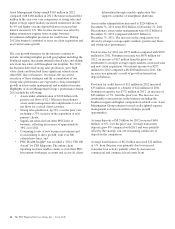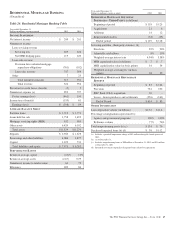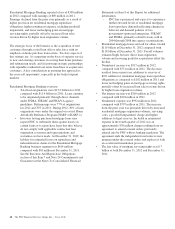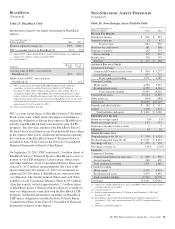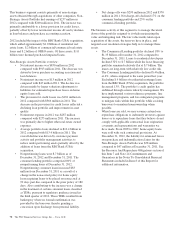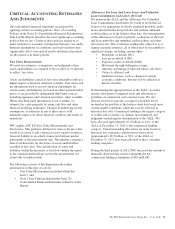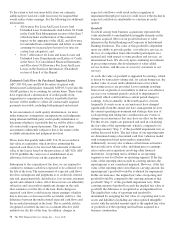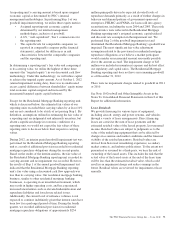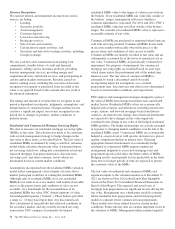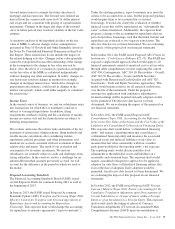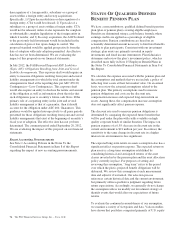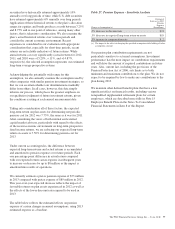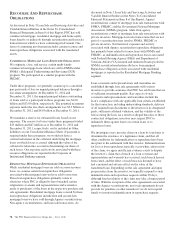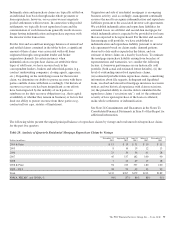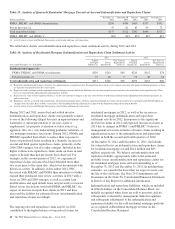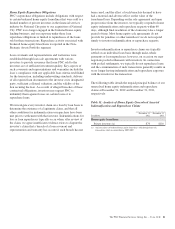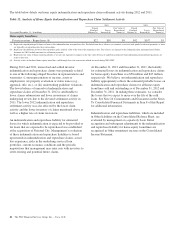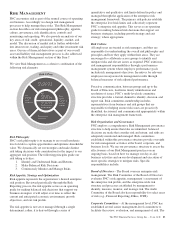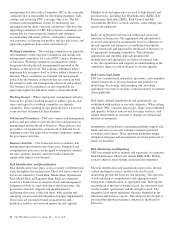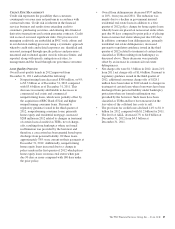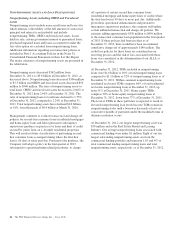PNC Bank 2012 Annual Report Download - page 95
Download and view the complete annual report
Please find page 95 of the 2012 PNC Bank annual report below. You can navigate through the pages in the report by either clicking on the pages listed below, or by using the keyword search tool below to find specific information within the annual report.derecognition of a foreign entity, subsidiary or a group of
assets within a foreign entity and in step acquisitions.
Specifically, 1) Upon deconsolidation or derecognition of a
foreign entity, CTA would be released; 2) Upon sale of a
subsidiary or a group of assets within a foreign entity, CTA
would not be released, unless it also represents the complete
or substantially complete liquidation of the foreign entity in
which it resides; and 3) In a step acquisition, the AOCI related
to the previously held investment would be included in the
calculation of gain or loss upon change in control. The
proposed standard would be applied prospectively from the
date of adoption with early adoption permitted. An effective
date has not yet been determined. We are evaluating the
impact of this proposal on our financial statements.
In July 2012, the FASB issued Proposed ASU Liabilities
(Topic 405): Obligations Resulting from Joint and Several
Liability Arrangements. This exposure draft would require an
entity to measure obligations resulting from joint and several
liability arrangements for which the total amount under the
arrangement is fixed at the reporting date per ASC 450-20,
Contingencies—Loss Contingencies. This exposure draft
would also require an entity to disclose the nature and amount
of the obligation as well as information about the risks that
such obligations pose to an entity’s future cash flows. If the
primary role of a reporting entity in the joint and several
liability arrangement is that of a guarantor, then it should
account for the obligation under ASC 460, Guarantees. This
guidance would be applied retrospectively to all prior periods
presented for those obligations resulting from joint and several
liability arrangements that exist at the beginning of an entity’s
fiscal year of adoption. The effective date has not yet been
determined. The comment period ended September 20, 2012.
We are evaluating the impact of this proposal on our financial
statements.
Recent Accounting Pronouncements
See Note 1 Accounting Policies in the Notes To the
Consolidated Financial Statements in Item 8 of this Report
regarding the impact of new accounting pronouncements.
S
TATUS
O
F
Q
UALIFIED
D
EFINED
B
ENEFIT
P
ENSION
P
LAN
We have a noncontributory, qualified defined benefit pension
plan (plan or pension plan) covering eligible employees.
Benefits are determined using a cash balance formula where
earnings credits are applied as a percentage of eligible
compensation. Pension contributions are based on an
actuarially determined amount necessary to fund total benefits
payable to plan participants. Consistent with our investment
strategy, plan assets are primarily invested in equity
investments and fixed income instruments. Plan fiduciaries
determine and review the plan’s investment policy, which is
described more fully in Note 15 Employee Benefit Plans in
the Notes To Consolidated Financial Statements in Item 8 of
this Report.
We calculate the expense associated with the pension plan and
the assumptions and methods that we use include a policy of
reflecting trust assets at their fair market value. On an annual
basis, we review the actuarial assumptions related to the
pension plan. The primary assumptions used to measure
pension obligations and costs are the discount rate,
compensation increase and expected long-term return on
assets. Among these, the compensation increase assumption
does not significantly affect pension expense.
The discount rate used to measure pension obligations is
determined by comparing the expected future benefits that
will be paid under the plan with yields available on high
quality corporate bonds of similar duration. The impact on
pension expense of a 0.5% decrease in discount rate in the
current environment is $21 million per year. In contrast, the
sensitivity to the same change in discount rate in a higher
interest rate environment is less significant.
The expected long-term return on assets assumption also has a
significant effect on pension expense. The expected return on
plan assets is a long-term assumption established by
considering historical and anticipated returns of the asset
classes invested in by the pension plan and the asset allocation
policy currently in place. For purposes of setting and
reviewing this assumption, “long term” refers to the period
over which the plan’s projected benefit obligations will be
disbursed. We review this assumption at each measurement
date and adjust it if warranted. Our selection process
references certain historical data and the current environment,
but primarily utilizes qualitative judgment regarding future
return expectations. Accordingly, we generally do not change
the assumption unless we modify our investment strategy or
identify events that would alter our expectations of future
returns.
To evaluate the continued reasonableness of our assumption,
we examine a variety of viewpoints and data. Various studies
have shown that portfolios comprised primarily of U.S. equity
76 The PNC Financial Services Group, Inc. – Form 10-K


